
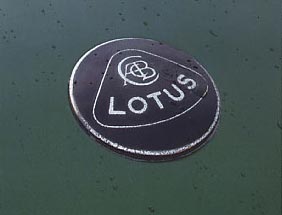
New Info from a Factory Insider
April 2008
The oval Green Gold badge was introduced by The new Chairman and head of BCA, David Wickens, as he didn't want the Chapman association at the time, prefering instead to try and force a new image on Lotus. It was Oval, not round as past badges had been, it didn't include ACBC at all and the Lotus words were in a different font and interlinked. This was brought in in 1984, despite the protestations of several Directors. It's said that Mike Kimberley nearly quit because of it.
18 months later (give or take a while for stock to run out) Mike Kimberley added in the ACBC part at the top of the badge. This again nearly ended MJK's career as it was done on his authority, wanting, quite correctly, to use Lotus's Chapman heritage and the racing implications associated to it . The badge was still, however, BRG and oval. It wasn't until 2 years later (again give or take stocks running out) that they managed to change the Oval badge back to the badge we all know and love, with the approval of GM.
The Oval Black and Gold oval badge was fitted because of the history of bringing out Black nose badges after Colin died and not all colours of cars suited the Green.
Because the Oval badges were only produced over a few years, they are rarer and more collectable.
Now obviously there are some anomolies, people having changed badges round, cars going out with the last of the old badges (waste not, want not) however the dates above are approximate and correct.

Black
Magic
LotusLife
Feb/Mar 2002
From Lotus' earliest days every car was fitted with a nose badge comprising of Colin Chapman's monogram (ACBC) on a green quadrant background which is superimposed on a yellow circular plaque. However, from the late sixties onwards some cars appeared with mysterious all black nose badges.
There has been much speculation, gossip and debate as to how and why these back badges all of a sudden appeared. Here's the truth. Or at least one version of it!
The first black nose badge was made in 1967 for the Elan of the Sales Director at the time Graham Arnold. It was a one off. A year later the badges were placed on all cars made for a month, after the death of Double World Champion Jimmy Clark in a Formula 2 race. Once this batch had been used up, Lotus should have reverted to the green and yellow colours. But for reasons shrouded in mystery a batch of black badges was still occasionally ordered and fitted to cars at random as they left the factory. These later badges carried no special significance, although unfounded stories were quick to circulate that 'black badge' cars were special versions with better engines or suspension.
When Lotus won the World Championship for the 7th time in 1978, a batch of 100 commemorative Esprits had the specially made back nose badges inserted. The most recent black nose badge occurred in the mid eighties when Lotus was bought by General Motors. Someone at GM decided that the Lotus badge should be re-designed to a dark green or black. When GM sold Lotus to the Bugatti Group in the early nineties one of their first actions was to revert to an updated version of the original green and yellow nose badge. And last but not least, the black nose badge was last seen in 1999 on the black livery heritage version of the Elise. The big question is, where will it appear next?
The
LOTUS Nose
Badge
The
letters at the top of the triangular green lozenge are " A -
C - B - C ".
. 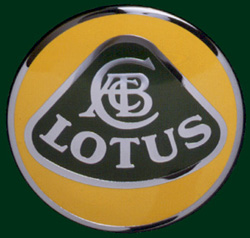
They are the initials of Anthony Colin Bruce Chapman,
the Designer, Builder, and Founder of LOTUS.
Colin
Chapman calls his car a LOTUS because once you drive it, you will
forget all the others.
In the logo, the initials are larger than the word LOTUS, for-Lotus-is-indeed
Anthony-Colin-Bruce-Chapman !
The triangular lozenge is colored British Racing Green,
which is the color designated for cars of British origin that will
be competing in international events.
The lozenge is placed on a field of yellow, signifying the sunny days
that Chapman
hoped would lie ahead for his company.
All Lotus competition cars were painted British Racing Green with
Yellow detailing,
until the advent of paid corporate sponsership which turned them into
rolling billboards.
In April of 1968, World Champion Driver Jim Clark was killed at Hockenheim,
Germany, while driving
a Lotus Type 48 in a Formula 2 race.
From
that day foreward, all LOTUS cars have worn a black nose badge, out
of respect for his passing.
. 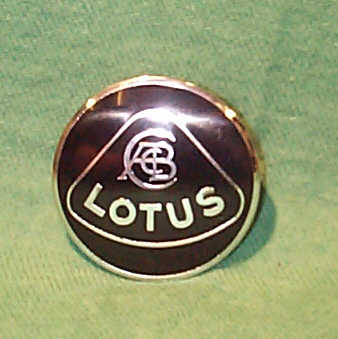
The practice was carried foreward upon the death of Anthony Colin
Bruce Chapman, in 1982.
Any Lotus street car that was manufactured after 1968,
that is not wearing a black nose badge is pretending to be something
that it is not !
Under General Motors ownership, a new "Corprate Logo" was
designed for the Esprit Turbo.
This new logo was designed without the A - C - B - C- initials on
it.
..
This transitional badge is reproduced for you below.
. 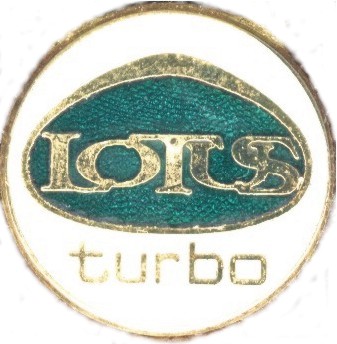
.
A later badge that was used on the Esprit, included very small initials.
I believe that this was done to play down Colin Chapman's automotive
contributions.
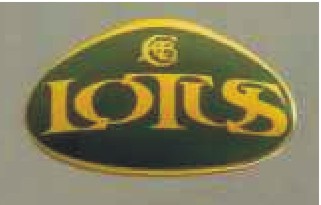
He would, after all, be a very tough act to follow !
Such is the fate of fame in a world of hostle corporate take-overs.
.
To their credit, when Bugatti bought Lotus they restored the original
green and yellow logo, and
thus tried to give a sense of continuity to the company.
.
In truth, I'm-sorry-to say, the spirit of Lotus passed away when-Colin
did.
|
|